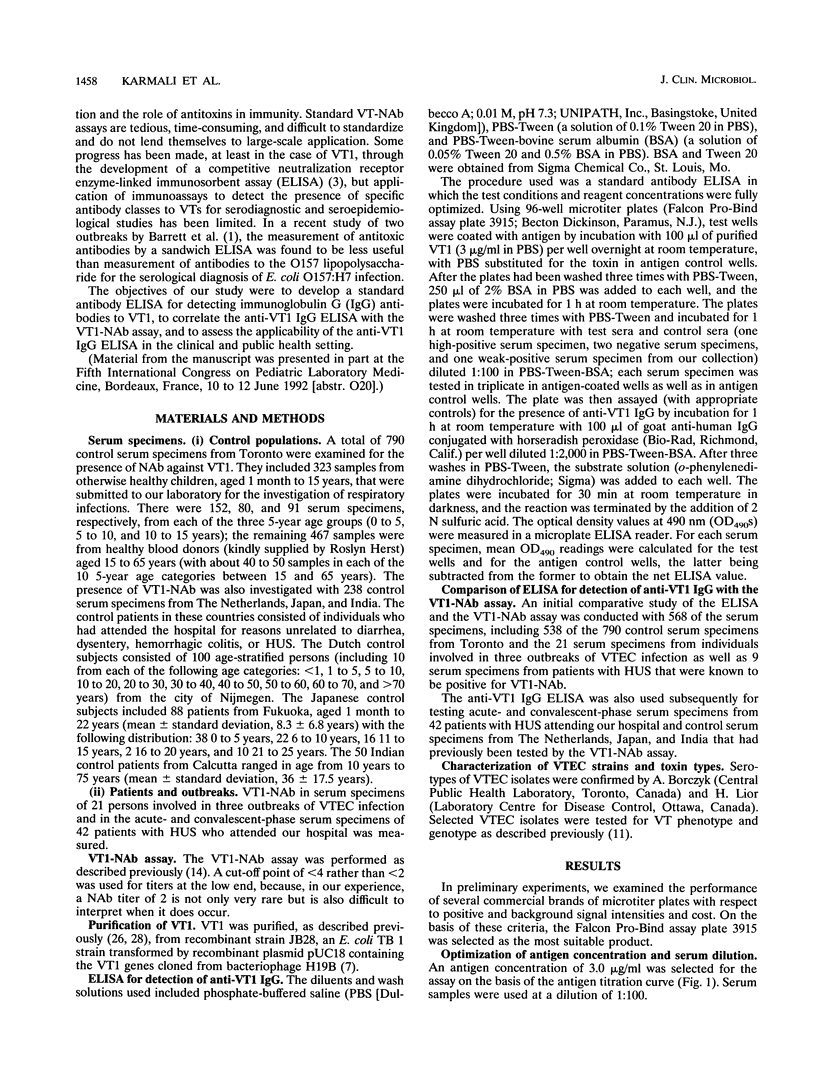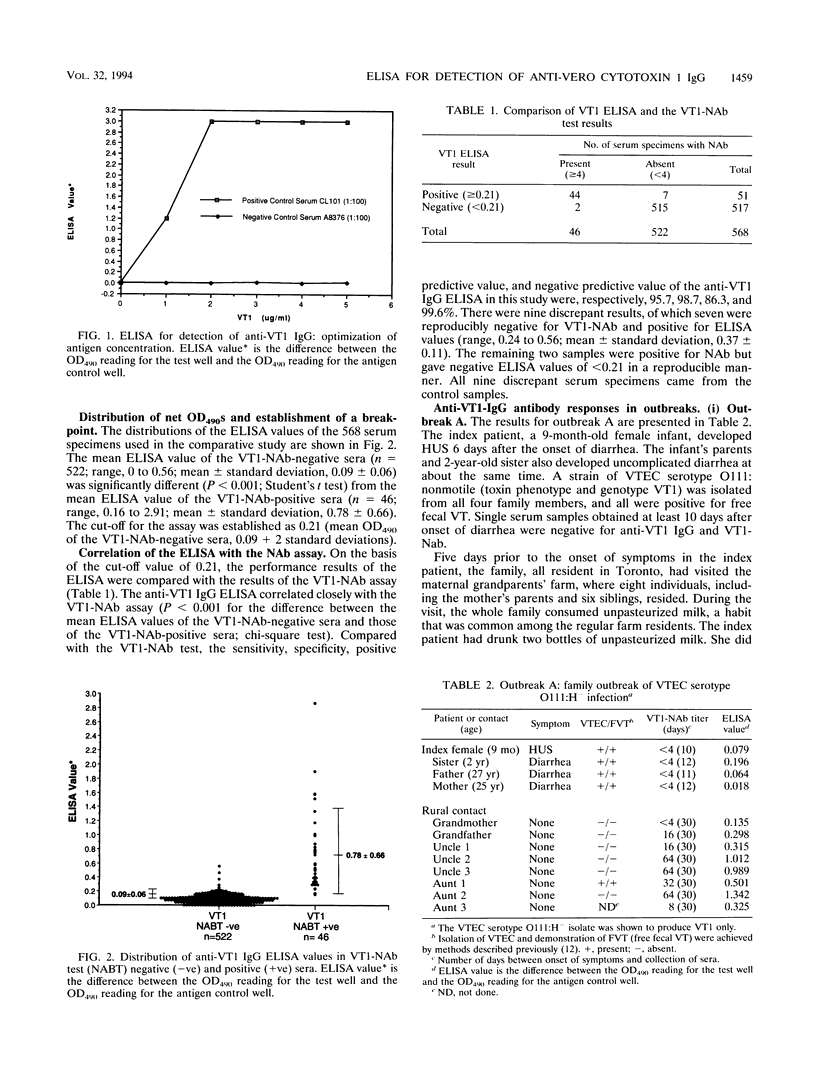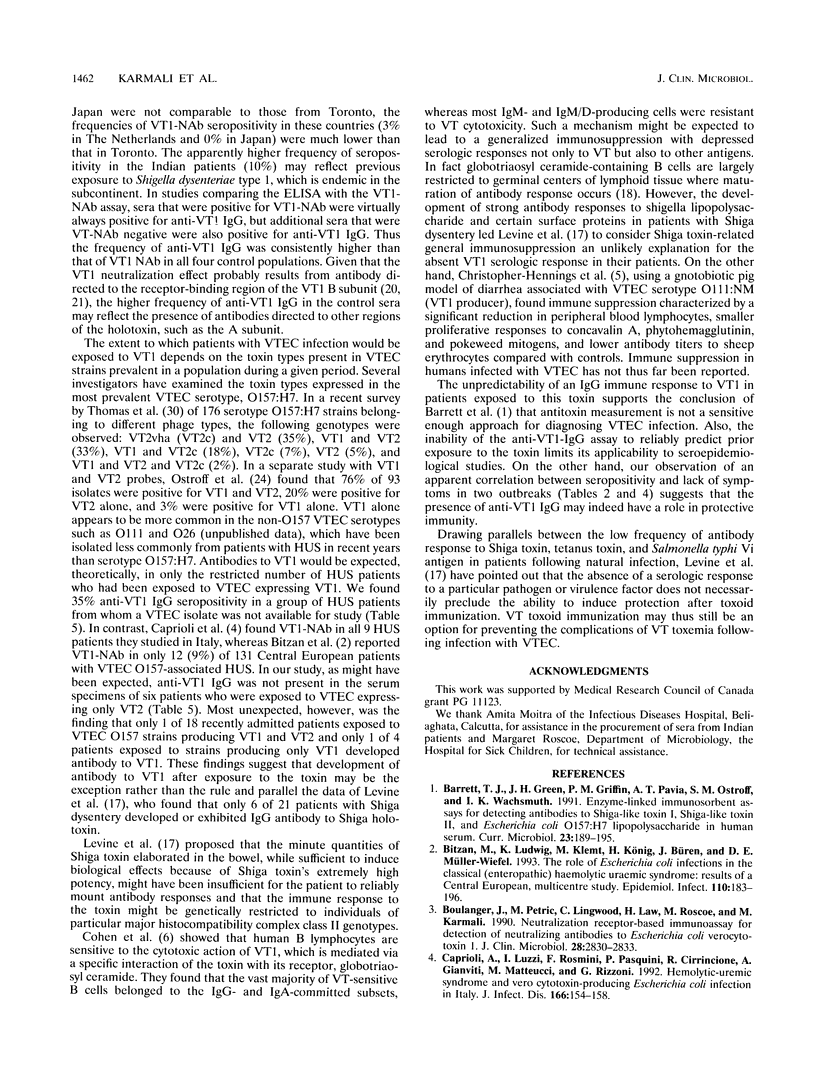Abstract
The frequency of Vero cytotoxin 1 (VT1)-neutralizing antibody (NAb) in serum specimens from 790 age-stratified (0 to 70 years) control individuals from Toronto was 61 of 790 (7.7%), with a peak of 19% in the 20- to 30-year-old age group and a second peak of 16.7% in the 60- to 70-year-old age group. A total of 568 serum specimens, including 538 from the 790 Toronto control subjects, 21 from patients from three outbreaks of VT-producing Escherichia coli (VTEC) infection, and 9 known VT1-NAb-positive serum specimens from patients with hemolytic-uremic syndrome (HUS), were then tested for the presence of anti-VT1 immunoglobulin G (IgG) by an enzyme-linked immunosorbent assay (ELISA). The mean ELISA values of 522 VT1-NAb-negative serum specimens and 46 VT1-NAb-positive serum specimens were 0.09 +/- 0.06 (range, 0 to 0.56) and 0.78 +/- 0.66 (range, 0.16 to 2.91), respectively (P < 0.001; Student's t test). With a breakpoint of 0.21 (mean ELISA value of the VT1-NAb-negative sera + 2 standard deviations), the sensitivity, specificity, positive predictive value, and negative predictive value of the VT1 IgG ELISA compared with those of the VT1-NAb assay were, respectively, 95.7, 98.7, 86.3, and 99.6%. There were nine discrepant serum specimens, of which seven were anti-VT1 IgG positive and VT1-NAb negative and two were anti-VT1 IgG negative and VT1-NAb positive. The ELISA was also used for testing 238 control serum specimens from The Netherlands, Japan, and India and acute- and convalescent-phase serum specimens from 42 Toronto patients with HUS. The frequencies of anti-VT1 IgG (with VT1-NAb frequencies in parantheses) in control sera from the Netherlands, Japan, and India were 6% (3%), 1.1% (0%), and 12% (10%), respectively, with no age clustering. The frequencies of anti-VT1 IgG seropositivity in HUS patients were 5 of 14 (35.7%) in patients with unknown toxin exposure, 2 of 22 (9.1%) in individuals with known exposure to VT1 plus VT2 or VT1 alone, and 0 of 6 (0%) in patients exposed to only VT2. Development of serum anti-VT1 IgG response appears to be the exception rather than the rule in sporadic HUS patients infected with VTEC expressing VT1. However, in two family outbreaks associated with VTEC strains expressing VT1 alone and VT1 plus VT2, respectively, the presence of anti-VT1 IgG in virtually all exposed individuals who remained symptom free suggests that the presence of antibody was associated with protection.
Full text
PDF






Selected References
These references are in PubMed. This may not be the complete list of references from this article.
- Bitzan M., Ludwig K., Klemt M., König H., Büren J., Müller-Wiefel D. E. The role of Escherichia coli O 157 infections in the classical (enteropathic) haemolytic uraemic syndrome: results of a Central European, multicentre study. Epidemiol Infect. 1993 Apr;110(2):183–196. doi: 10.1017/s0950268800068102. [DOI] [PMC free article] [PubMed] [Google Scholar]
- Boulanger J., Petric M., Lingwood C., Law H., Roscoe M., Karmali M. Neutralization receptor-based immunoassay for detection of neutralizing antibodies to Escherichia coli verocytotoxin 1. J Clin Microbiol. 1990 Dec;28(12):2830–2833. doi: 10.1128/jcm.28.12.2830-2833.1990. [DOI] [PMC free article] [PubMed] [Google Scholar]
- Caprioli A., Luzzi I., Rosmini F., Pasquini P., Cirrincione R., Gianviti A., Matteucci M. C., Rizzoni G. Hemolytic-uremic syndrome and Vero cytotoxin-producing Escherichia coli infection in Italy. The HUS Italian Study Group. J Infect Dis. 1992 Jul;166(1):154–158. doi: 10.1093/infdis/166.1.154. [DOI] [PubMed] [Google Scholar]
- Christopher-Hennings J., Willgohs J. A., Francis D. H., Raman U. A., Moxley R. A., Hurley D. J. Immunocompromise in gnotobiotic pigs induced by verotoxin-producing Escherichia coli (O111:NM). Infect Immun. 1993 Jun;61(6):2304–2308. doi: 10.1128/iai.61.6.2304-2308.1993. [DOI] [PMC free article] [PubMed] [Google Scholar]
- Cohen A., Madrid-Marina V., Estrov Z., Freedman M. H., Lingwood C. A., Dosch H. M. Expression of glycolipid receptors to Shiga-like toxin on human B lymphocytes: a mechanism for the failure of long-lived antibody response to dysenteric disease. Int Immunol. 1990;2(1):1–8. doi: 10.1093/intimm/2.1.1. [DOI] [PubMed] [Google Scholar]
- De Grandis S., Ginsberg J., Toone M., Climie S., Friesen J., Brunton J. Nucleotide sequence and promoter mapping of the Escherichia coli Shiga-like toxin operon of bacteriophage H-19B. J Bacteriol. 1987 Sep;169(9):4313–4319. doi: 10.1128/jb.169.9.4313-4319.1987. [DOI] [PMC free article] [PubMed] [Google Scholar]
- Fong J. S., de Chadarevian J. P., Kaplan B. S. Hemolytic-uremic syndrome. Current concepts and management. Pediatr Clin North Am. 1982 Aug;29(4):835–856. doi: 10.1016/s0031-3955(16)34216-x. [DOI] [PubMed] [Google Scholar]
- Head S. C., Karmali M. A., Roscoe M. E., Petric M., Strockbine N. A., Wachsmuth I. K. Serological differences between verocytotoxin 2 and shiga-like toxin II. Lancet. 1988 Sep 24;2(8613):751–751. doi: 10.1016/s0140-6736(88)90228-0. [DOI] [PubMed] [Google Scholar]
- Hii J. H., Gyles C., Morooka T., Karmali M. A., Clarke R., De Grandis S., Brunton J. L. Development of verotoxin 2- and verotoxin 2 variant (VT2v)-specific oligonucleotide probes on the basis of the nucleotide sequence of the B cistron of VT2v from Escherichia coli E32511 and B2F1. J Clin Microbiol. 1991 Dec;29(12):2704–2709. doi: 10.1128/jcm.29.12.2704-2709.1991. [DOI] [PMC free article] [PubMed] [Google Scholar]
- Karmali M. A. Infection by verocytotoxin-producing Escherichia coli. Clin Microbiol Rev. 1989 Jan;2(1):15–38. doi: 10.1128/cmr.2.1.15. [DOI] [PMC free article] [PubMed] [Google Scholar]
- Karmali M. A., Petric M., Lim C., Fleming P. C., Arbus G. S., Lior H. The association between idiopathic hemolytic uremic syndrome and infection by verotoxin-producing Escherichia coli. J Infect Dis. 1985 May;151(5):775–782. doi: 10.1093/infdis/151.5.775. [DOI] [PubMed] [Google Scholar]
- Karmali M. A., Steele B. T., Petric M., Lim C. Sporadic cases of haemolytic-uraemic syndrome associated with faecal cytotoxin and cytotoxin-producing Escherichia coli in stools. Lancet. 1983 Mar 19;1(8325):619–620. doi: 10.1016/s0140-6736(83)91795-6. [DOI] [PubMed] [Google Scholar]
- Konowalchuk J., Speirs J. I., Stavric S. Vero response to a cytotoxin of Escherichia coli. Infect Immun. 1977 Dec;18(3):775–779. doi: 10.1128/iai.18.3.775-779.1977. [DOI] [PMC free article] [PubMed] [Google Scholar]
- Levine M. M., McEwen J., Losonsky G., Reymann M., Harari I., Brown J. E., Taylor D. N., Donohue-Rolfe A., Cohen D., Bennish M. Antibodies to shiga holotoxin and to two synthetic peptides of the B subunit in sera of patients with Shigella dysenteriae 1 dysentery. J Clin Microbiol. 1992 Jul;30(7):1636–1641. doi: 10.1128/jcm.30.7.1636-1641.1992. [DOI] [PMC free article] [PubMed] [Google Scholar]
- Lingwood C. A. Verotoxins and their glycolipid receptors. Adv Lipid Res. 1993;25:189–211. [PubMed] [Google Scholar]
- Lopez E. L., Diaz M., Grinstein S., Devoto S., Mendilaharzu F., Murray B. E., Ashkenazi S., Rubeglio E., Woloj M., Vasquez M. Hemolytic uremic syndrome and diarrhea in Argentine children: the role of Shiga-like toxins. J Infect Dis. 1989 Sep;160(3):469–475. doi: 10.1093/infdis/160.3.469. [DOI] [PubMed] [Google Scholar]
- O'Brien A. D., Holmes R. K. Shiga and Shiga-like toxins. Microbiol Rev. 1987 Jun;51(2):206–220. doi: 10.1128/mr.51.2.206-220.1987. [DOI] [PMC free article] [PubMed] [Google Scholar]
- O'Brien A. D., Tesh V. L., Donohue-Rolfe A., Jackson M. P., Olsnes S., Sandvig K., Lindberg A. A., Keusch G. T. Shiga toxin: biochemistry, genetics, mode of action, and role in pathogenesis. Curr Top Microbiol Immunol. 1992;180:65–94. doi: 10.1007/978-3-642-77238-2_4. [DOI] [PubMed] [Google Scholar]
- Obrig T. G., Del Vecchio P. J., Brown J. E., Moran T. P., Rowland B. M., Judge T. K., Rothman S. W. Direct cytotoxic action of Shiga toxin on human vascular endothelial cells. Infect Immun. 1988 Sep;56(9):2373–2378. doi: 10.1128/iai.56.9.2373-2378.1988. [DOI] [PMC free article] [PubMed] [Google Scholar]
- Ostroff S. M., Tarr P. I., Neill M. A., Lewis J. H., Hargrett-Bean N., Kobayashi J. M. Toxin genotypes and plasmid profiles as determinants of systemic sequelae in Escherichia coli O157:H7 infections. J Infect Dis. 1989 Dec;160(6):994–998. doi: 10.1093/infdis/160.6.994. [DOI] [PubMed] [Google Scholar]
- Pai C. H., Ahmed N., Lior H., Johnson W. M., Sims H. V., Woods D. E. Epidemiology of sporadic diarrhea due to verocytotoxin-producing Escherichia coli: a two-year prospective study. J Infect Dis. 1988 May;157(5):1054–1057. doi: 10.1093/infdis/157.5.1054. [DOI] [PubMed] [Google Scholar]
- Richardson S. E., Karmali M. A., Becker L. E., Smith C. R. The histopathology of the hemolytic uremic syndrome associated with verocytotoxin-producing Escherichia coli infections. Hum Pathol. 1988 Sep;19(9):1102–1108. doi: 10.1016/s0046-8177(88)80093-5. [DOI] [PubMed] [Google Scholar]
- Richardson S. E., Rotman T. A., Jay V., Smith C. R., Becker L. E., Petric M., Olivieri N. F., Karmali M. A. Experimental verocytotoxemia in rabbits. Infect Immun. 1992 Oct;60(10):4154–4167. doi: 10.1128/iai.60.10.4154-4167.1992. [DOI] [PMC free article] [PubMed] [Google Scholar]
- Riley L. W., Remis R. S., Helgerson S. D., McGee H. B., Wells J. G., Davis B. R., Hebert R. J., Olcott E. S., Johnson L. M., Hargrett N. T. Hemorrhagic colitis associated with a rare Escherichia coli serotype. N Engl J Med. 1983 Mar 24;308(12):681–685. doi: 10.1056/NEJM198303243081203. [DOI] [PubMed] [Google Scholar]
- Thomas A., Smith H. R., Rowe B. Use of digoxigenin-labelled oligonucleotide DNA probes for VT2 and VT2 human variant genes to differentiate Vero cytotoxin-producing Escherichia coli strains of serogroup O157. J Clin Microbiol. 1993 Jul;31(7):1700–1703. doi: 10.1128/jcm.31.7.1700-1703.1993. [DOI] [PMC free article] [PubMed] [Google Scholar]


